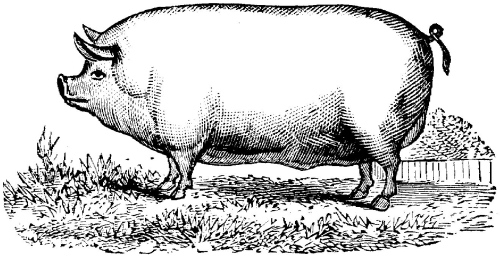Braised pork shoulder with rhubarb sauce.
And cider too, but brevity can be the soul of virtue. The recipe is based rather loosely on one from Jennifer McLagan’s Odd Bits. It strikes the Editor as odd that Ms. McLagan considers shoulder odd, but then she is Canadian and perhaps finds shoulder a sort of unruly cut. They ordinarily like to keep things polite and orderly north of the border. This should serve eight diners, normally in the colder months that are about to be upon us.
 a shoulder of pork with its skin and bone (usually about 6 lb)
a shoulder of pork with its skin and bone (usually about 6 lb)- salt and pepper
- about a Tablespoon of lard (preferred) or neutral oil
- about 2 cups hard cider
- a peeled, cored and diced apple
- about 4 garlic cloves, peeled and lightly crushed
- 2 peeled and chopped shallots
- 3 or 4 bay leaves
- about a heaped ¼ teaspoon cayenne, more or less
- scant ½ teaspoon mace or nutmeg
- 2 Tablespoons treacle or molasses (see the Notes)
- 1 lb rhubarb cut into 1 inch lengths
- Cut the skin from the pork in a single sheet, then season the meat generously with salt and pepper.
Preheat the oven to 325°. - Heat the lard in a heavy pot big enough to hold the shoulder and wrestle it brown. The pot should have a lid.
- Remove the shoulder from the pot, then pour on the cider and bring it to a boil as you scrape the debris from the bottom of the pot.
- Turn off the heat and strew the apple, garlic, shallots, bay, cayenne and mace about the pot.
- Dump the shoulder into the pot, salt one side of its skin and lay it atop the meat.
- Cover the pot and braise the shoulder for about 2 hours.
- Uncover the pot, remove the skin and continue to braise the shoulder until the pork is most tender, usually in about another hour.
- Get the shoulder out of the pot and tent it with foil to keep it warm.
- Strain the sauce, let it cool a bit to skim the fat, then and return it to the pot over high heat to reduce it by half.
- Whisk the treacle or molasses into the pot, add the rhubarb and cook it as much or little as you like. After about 5 minutes it will be barely tender; after a while it will dissolve.
- Pop the sheet of pork skin under the broiler to crisp it while the sauce simmers and you will get crackling.
- Serve the pork and its sauce with potatoes or grits and something green.
Notes:
-Do not despair if you can find neither skin nor bone with your shoulder in the overprocessed milieu of the supermarket. Make the dish anyway.
-If you do have a bone it will help make a good stock. Pork stock is an underutilized Thing We Like.
-McLagan covers the pork wit damp parchment paper for the first two hours. We have not found that necessary. The pork should not go dry but if you are a risk averse soul, go ahead and tear off a piece of parchment.
-McLagan uses sweet, nonalcoholic cider. We like the dryer tang of the hard stuff better. You could go half and half.
-She also flavors her pork with cardamom and dried chiles instead of cayenne and mace. The choice is yours but cardamom is not popular in the house of the Editor for use in recipes other than baked desserts and savory food from the Subcontinent.
-Honey is her sweetener of choice but the Editor frequently finds it cloying and anyway likes the ambiguity of treacle, which lacks the sulphurous whiff of most molasses.
-McLagan suggest the use of belly, hocks or neck as alternatives to the shoulder. We would say yes to the belly (you will get a richer, fattier result and no to the others.
-She submerges the skin in the sauce after two hours, then throws it away when the pork itself is done. Argh.

